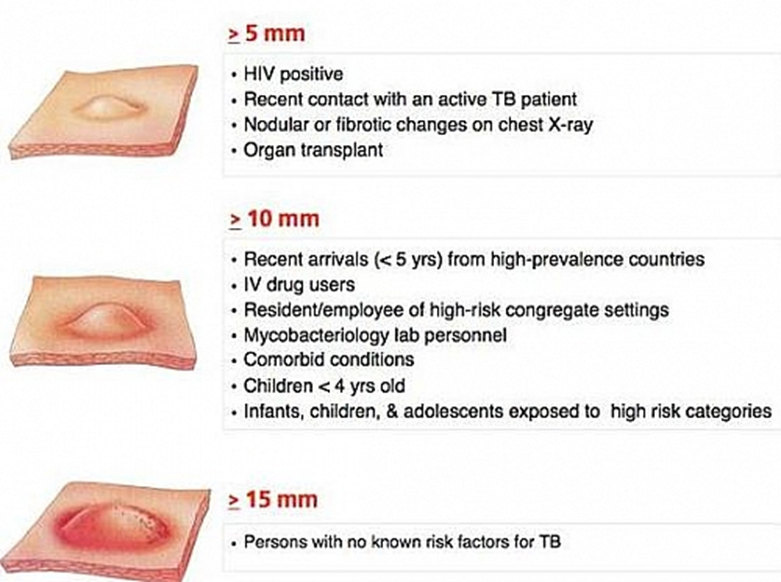Which nursing assessment indicates a positive reading of a tuberculin (TB) skin test?
1 day after injection with a 10-mm area of redness and swelling
2 days after injection with a 5-mm area of redness and swelling
4 days after injection with a 3-mm area of redness and swelling
5 days after injection with a 2-mm area of redness and swelling
The Correct Answer is A
A. 1 day after injection with a 10-mm area of redness and swelling:
This may suggest a positive reading, but induration size is the primary criterion for interpretation, not just redness and swelling.
B. 2 days after injection with a 5-mm area of redness and swelling:
Similar to option A, a 5-mm area of redness and swelling alone does not definitively indicate a positive TB skin test. Again, without information on the size of the induration, we cannot determine if this reading is positive.
C. 4 days after injection with a 3-mm area of redness and swelling:
Once more, a 3-mm area of redness and swelling alone does not definitively indicate a positive TB skin test. As with the previous options, the size of the induration is the critical factor for interpretation.
D. 5 days after injection with a 2-mm area of redness and swelling:
As with the other options, a 2-mm area of redness and swelling alone does not definitively indicate a positive TB skin test. The presence and size of induration are essential for accurate interpretation.

Nursing Test Bank
Naxlex Comprehensive Predictor Exams
Related Questions
Correct Answer is A
Explanation
A. Provide humidified oxygen.
Humidified oxygen adds moisture to the air, which can help to thin secretions in the airway. Thinning the secretions makes them easier to clear, particularly for patients with copious and tenacious secretions, such as those following a tracheostomy.
B. Perform chest physiotherapy prior to suctioning.
Chest physiotherapy techniques, such as percussion and vibration, can help to mobilize secretions in the lungs and airways. While this may indirectly assist in clearing secretions, it does not directly address the issue of thinning the secretions, which is the primary concern in this scenario.
C. Prelubricate the suction catheter tip with sterile saline when suctioning the airway.
Prelubricating the suction catheter tip with sterile saline before suctioning can help reduce friction and potential trauma to the airway. While this can be beneficial for airway management, it does not directly address the need to thin copious and tenacious secretions.
D. Hyperventilate the client with 100% oxygen before suctioning the airway.
Hyperventilating the client with 100% oxygen before suctioning is not recommended. It can lead to respiratory alkalosis, which is a condition characterized by decreased levels of carbon dioxide in the blood. This can worsen the client's condition and may lead to adverse effects. Additionally, it does not directly address the need to thin secretions.
Correct Answer is B
Explanation
First, we need to find out how many milligrams (mg) are in 1 milliliter (mL) of the available diphenhydramine solution:
12.5 mg/5 mL
To find out how many milligrams are in 1 mL, we divide the total milligrams by the total milliliters:
12.5 mg ÷ 5 mL = 2.5 mg/mL
Now that we know the concentration of diphenhydramine is 2.5 mg/mL, we can calculate the dose needed for the order of 25 mg:
25 mg ÷ 2.5 mg/mL = 10 mL
Whether you are a student looking to ace your exams or a practicing nurse seeking to enhance your expertise , our nursing education contents will empower you with the confidence and competence to make a difference in the lives of patients and become a respected leader in the healthcare field.
Visit Naxlex, invest in your future and unlock endless possibilities with our unparalleled nursing education contents today
Report Wrong Answer on the Current Question
Do you disagree with the answer? If yes, what is your expected answer? Explain.
Kindly be descriptive with the issue you are facing.
